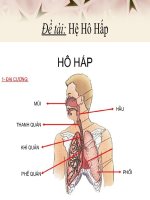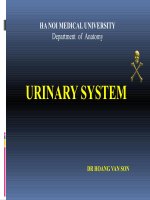BAI GIANG HE HO HAP (respiratory system)
Bạn đang xem bản rút gọn của tài liệu. Xem và tải ngay bản đầy đủ của tài liệu tại đây (3.91 MB, 73 trang )
Purves et al., Life: The Science of Biology
Respiratory system
Respiratory system
Key processes and concepts
•
Function of the respiratory system. The role of O2 in cellular respiration. External and internal respiration
•
Properties of respiratory gases related to the diversity in structures of respiratory systems in animals
•
Physical basis of the transport of respiratory gases and lung ventilation: diffusion , bulk flow and related
equations; ideal gas law, poiseuille's law, surface tension, partial pressure
•
Structures of respiratory system in human: conducting zone, respiratory zone, alveolus, respiratory
membrane, pleural sac
•
Lung ventilation and bulk flow: atmospheric pressure (Patm), alveoli pressure (Palv), negative intrapleural
pressure (Pip)
–
Respiratory muscles
–
Lung compliance, pulmonary surfactant
•
Gas exchange at the lungs and at the tissues –diffusion and partial pressure
•
The transport of oxygen in the circulation , oxygen saturation of Hemoglobin, PO250
•
Cacbonic anhydrase and the transport of CO2 in the circulation
•
Control of respiration
Biochemical or Internal Respiration (Hô hấp trong) versus
Physiological or External Respiration (hô hấp ngoài)
1. Internal respiration deals with converting food
energy to ATP.
2. External respiration deals with the mechanics
of moving oxygen from the atmosphere into the
lungs and to the tissues and with moving carbon
dioxide from the tissues and the lungs to the
atmosphere.
Specific terms
• Pneumo-
-Pneumothorax
-Pneumonia
-Pneumograph
-Pulmonary system
THE BIG PICTURE IN RESPIRATION
• Function is to maintain levels of CO2
and O2 in body tissues
• Homeostatic Systems help maintain
ideal levels of O2 and CO2
Why living organism need Oxygen?
Why we need to breath constantly?
ATP
— each cell must make its
own ATP
—ATP is not stored by cells
to any substantial extent
Nguồn: C.L. Standfield 2011
ATP production
/>
•aerobic catabolism:
1 Glucose + O2 -> 38 ATP + CO2 +H2O
•anaerobic glycolysis:
1 Glucose-> 2 ATP + lactic acid
The amount of ATP produced is nearly 20 times higher
when O2 is present
Properties of respiratory gases related to the diversity
in structures of respiratory systems in animals
• Percentages of CO2 and O2 in atmosphere
• Solubility of CO2 and O2 in fresh and in salt
water
• Concentration of CO2 and O2 in air and water
• Density of gases and water
Gases in Atmosphere:
–Nitrogen= 78%
–Oxygen= 21%
–Carbon Dioxide = 0.03%
Partial pressure
• Partial Pressure Definition and Units
• At sea level atmospheric pressure Patm= 760 mm Hg
Patm = P + PN2 + PCO2
O2
– PO2 = 760 mm Hg X 21% = 160 mm Hg.
– PN2= 760 x 78% =593 mm Hg
– PCO2= 760 x 0.03% = 0.23 mm Hg
Henry’s Law (calculating how much gas
can dissolve in a solution)
C=kxP
C= molar concentration of dissolved gas (moles/liter or mM/L)
P= partial pressure of gas (mm Hg)
k = solubility constant of gas in solvent (moles/liter mm Hg or mM/L mm Hg)
k = C/P
(solubility (k) = C (molar concentration of the gas) divided by P (partial pressure of the gas)
Oxygen Solubility: Air vs Water
Air
Water
0.052 mM/L mmHg
0.0015mM/LmmHg
kair / kwater = 34
--> problem in blood and role of hemoglobin
Carbon Dioxide Solubility: Air vs Water
Air
Water
0.052 mM/LmmHg
0.03 mM/LmmHg
kair / kwater = 1.7
Solubility CO2 in Water / Solubility O2 in Water
0.03 / 0.0015 mM/LmmHg = 20
Air versus Water
1. Air has 209 ml oxygen/liter
2. Water has 6.6 ml oxygen/liter
3. Water is 1000 times more dense than air
Purves et al., Life: The Science of Biology
Bulk flow/convection and diffusion
Diffusion- relies on thermal
energy; efficient over short
distances:
0.5m
Bulk Flow (Q)/convection relies
on fluid pressure gradient;
0.0001m
Uses ATP to generate pressure
gradient;
0.6m
0.0000
2m
Modified Fig. 21.6 . Hill at el, 2008
Works well over long distances
Purves et al., Life: The Science of Biology
Bulk flow and diffusion are both used in respiratory systems of all animals
to transport respiratory gases
• Upper airways
• Respiratory tract:
– conducting zone:
• Larynx (thanh quản)
• Pharynx (khí quản)
• (primary)
Bronchus/bronchi
(phế quản)
• Secondary bronchi
• Tertiary bronchi
– respiratory zone
Trachea (Khí quản)
• 10-11 cm long, 2-2.5 cm in diameter, run
parallel wit h and anterior to the esophagus
• 15-20 C-shaped bands of cartilage
•In the epithelium lining the conducting zone ( the
larynx and the trachea, also bronchi but lesser
extent):
− Goblet cells secret mucus trapping foreign
particles in inhaled air
− Ciliated cells -> muscus escalator: cilia (hair
like projections of ciliated cells) vibrate to
propel mucus containing trapped particles
−->glottis-> pharynx-> swallowed into
esophagus
•Branches in to left and right bronchi surrounded
by cartilage rings
Conducting zone: conducts air from the larynx to the lungs
Respiratory zone: sites of gas exchange within the lungs
• 300 million alveoli in
two lungs -> total
surface of 100m2
• Alveolar pores allow
equilibration of
pressure within the
lung
Cross section of an alveolus
• Type I alveolar cells:
epithelial cells making
up alveolar wall
• Type II alveolar cells
produce pulmonary
surfactant
• Respiratory membrane:
site across which gas
exchange occurs
(a)
(b)
resin cast of pulmonary arteries and bronchi
Scanning electro micrograph of capillaries around alveoli









